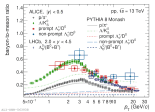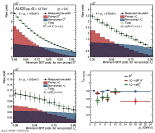Figures from paper submitted to Physical Review D
Abstract:
The production cross sections of ${\rm D^0}$ and $\Lambda^+_{\rm c}$ hadrons originating from beauty-hadron decays (i.e. non-prompt) were measured for the first time at midrapidity ($|y|<~0.5$) by the ALICE Collaboration in proton-proton collisions at a center-of-mass energy $\sqrt{s}=13$ TeV. They are described within uncertainties by perturbative QCD calculations employing the fragmentation fractions of beauty quarks to baryons measured at forward rapidity by the LHCb Collaboration. The ${\rm b\overline{b}}$ production cross section per unit of rapidity at midrapidity, estimated from these measurements, is ${\rm d}\sigma_{\rm b\overline{b}}/{\rm d}y|_{|y|<~0.5} = 83.1 \pm 3.5 (\mathrm{stat.}) \pm 5.4(\mathrm{syst.}) ^{+12.3}_{-3.2} (\mathrm{extrap.})\,\mu$b. The baryon-to-meson ratios are computed to investigate the hadronization mechanism of beauty quarks. The non-prompt $\Lambda^+_{\rm c}/{\rm D^0}$ production ratio has a similar trend to the one measured for the promptly produced charmed particles and to the p$/\pi^+$ and $\Lambda/{\rm K^0_S}$ ratios, suggesting a similar baryon-formation mechanism among light, strange, charm, and beauty hadrons. The $p_{\rm T}$-integrated non-prompt $\Lambda_{\rm c}/{\rm D^0}$ ratio is found to be significantly higher than the one measured in e$^+$e$^-$ collisions.
Phys. Rev. D 108, 112003 (2023)
e-Print: arXiv:2308.04873 | PDF | inSPIRE












